28. a Stairway of Coffins
My philosophy is that of a night-blooming flower, always blossoming at the least likely moment.
“Mournful November” & “But the dark feels different in November”
by Margaret Atwood, from “November” (collected in “You Are Happy”, 1974) // by Nina MacLaughlin, from “The Dark Feels Different in November” (the Paris Review, 2017)
TW. Recapping one of the lectures I attended this past October, there are a few mentions of necrophilia in Section II.I; they are brief and non-graphic. Section II.II contains an image of a prop from “Frankenstein” (2025) with slight gore. Reader / viewer discretion is advised, as always.
01/11/2025, London, UK
My dear,
It feels like only days ago I was writing my last letter to you. I never got to crawl out from behind my desk. The pit, the pendulum, and the veil separating them. Illusion of differing starting and ending points. Polluted Romanticism. November is an eerie haunting, like a hollowed-out tree trunk. Its roots spread a pattern of directions on how to get lost, luring you off the known path. Familiarity is a vice, and the fairytale warnings ringing in the back of your stubborn skull are not strong enough as a protection spell. So make a stronghold of your will with all the weapons of a fool; scissors / scythe / blindfold1. Forge the serpentine, slithering will to live even more intensely than you already do. Cocoon into the self.
This colder turn of the year always makes me yearn for medievalism; snow-kissed steel, dewdrops on blades. Desolation and devotion, love and violence. Twisting, grotesque spires on towering churches. I revisit the likes of Chrétien de Troyes, the Arthurian legends, but also the bitter gloom of video games like “Elden Ring” (2022)2 and “Dark Souls 3” (2016), the fantastical twists of “Game of Thrones” (2011-2019) or “House of the Dragon” (2022-). I like to feel the frigid cold of it seep into my bones, I enjoy the bleak melancholy of the season. The barren tree branches extend overhead like a network of arteries or nerves, mythology in bundles, feeding off of one another. The intertwined discipline of storytelling, my dear.
Let’s try unravelling this past month…
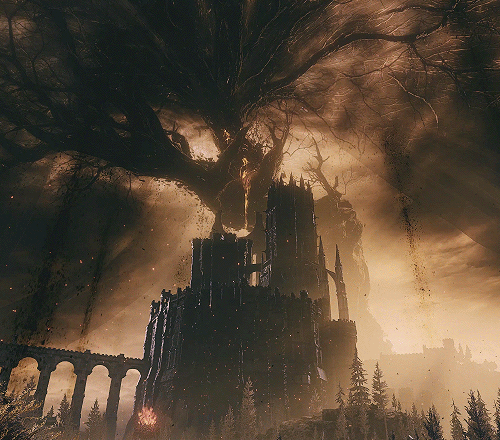
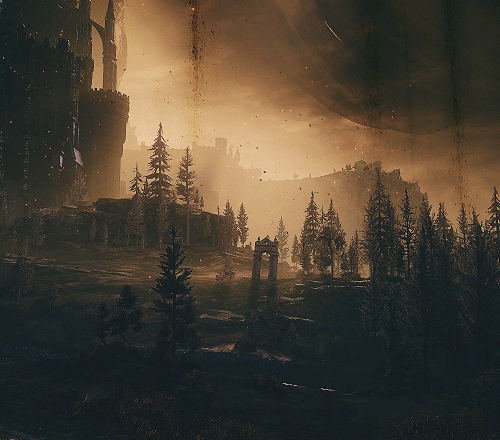
‧₊˚🖇️ ✮⋆˙ ₊˚💌⊹⋆。𖦹 ° This newsletter contains the following sections:
I. Archive Sources // II. Angels of Death (life updates, London Month of the Dead, “Frankenstein” film review) // III. Three Years, and Other Omens (notes on tWLS anniversary) /// “On the List” November // Outro
I. Archive Sources
[Error 404: Section missing. Try re-sending your prompt in thirty days. Thank you for your patience while we undertake some tech necromancy *:・゚✧*:・゚]
II. Angels of Death
“The boundaries which divide Life from Death are at best shadowy and vague. Who shall say where the one ends, and where the other begins?”
by Edgar Allan Poe, from “the Premature Burial” (1844)
This hazy, short-lived October, I attended five events as part of “London Month of the Dead”, saw Guillermo del Toro’s “Frankenstein” (2025) in cinema, and came face-to-face with the guillotine blade that killed Marie Antoinette. All things I am both eager and willing to report on, my dear. The autumnal months always pass us by in such a hurry, it is savvy to pin them down, document them, scrapbook them. See here, my magnum opus of arts and crafts.
II.I London Month of the Dead
The very first LMOTD event of the season I faithfully attended was a talk on necrophilia in art and culture, given by the wonderful Madeleine LeDespecter. It proved to be most enlightening, in many ways. For example, I learnt that there are ten classifications of necrophile3, ranging all the way from casual role players (resurrection fantasies, pretend-necrophiliac scenarios) to exclusive necrophiles (those who insist on the company of the dead only). Interestingly enough, the classification is very male-centred, and is based on the ability to get an erection, so there is a whole grey area when it comes to female necrophiles. But fear not, there are certainly classes with equal gender opportunity for involvement, such as in class II, the romantic necrophile.
These types develop necrophiliac tendencies only after the loss of a loved one, when the grief is too strong to let go. It’s a much more wholesome, Romantic class, based more on the idea of sanctifying or preserving the beloved, rather than having intercourse with the body. Artemisia II of Caria- who took a daily sacrament of her husband Mausolus’s4 ashes, mixed into her drink - falls into this category of the romantic necrophile. Another interesting class was class III, the necrophiliac fantasiser, which Mary Shelley would have been right at home in (if it was not outright based on her). It characteristically involves perverse or deviant behaviour associated with funerals, obituaries, and cemeteries— including sex in cemeteries. Very reminiscent of Mary and Percy’s cemetery “date”… If you know, you know. How outrageously scandalous!
Angels were the subject of the second talk (hosted by Dr. Emma Liggins), or more specifically the phenomenon of female angel statues in cemeteries, the Gothic “angels of death”. The lecture looked at the ubiquitousness of the mourner-as-woman, with examples from Southern Cemetery in Manchester, weaving a vast web of connections across art and literature; there is the Victorian ideal of the “angel in the house”, but on the other hand, all the known angels in [Christian] scripture are male. And yet still the woman gets cast as maiden, mourner, widow, angel. Looming atop the resting place of her beloved husband. Always beloved, never anything less. The carved wings, stuck, weeping— the angel in stone as mirror for the wife left behind. Pointing at the heavens as if mourning abandonment.
“you may not know what I mean by the Angel in the House. […] She was intensely sympathetic. She was immensely charming. She was utterly unselfish. She excelled in the difficult arts of family life. She sacrificed herself daily. […] Her purity was supposed to be her chief beauty — her blushes, her great grace.”
& “Killing the Angel in the House [is] part of the occupation of a woman writer.”
by Virginia Woolf, from “Professions for Women” (1931)
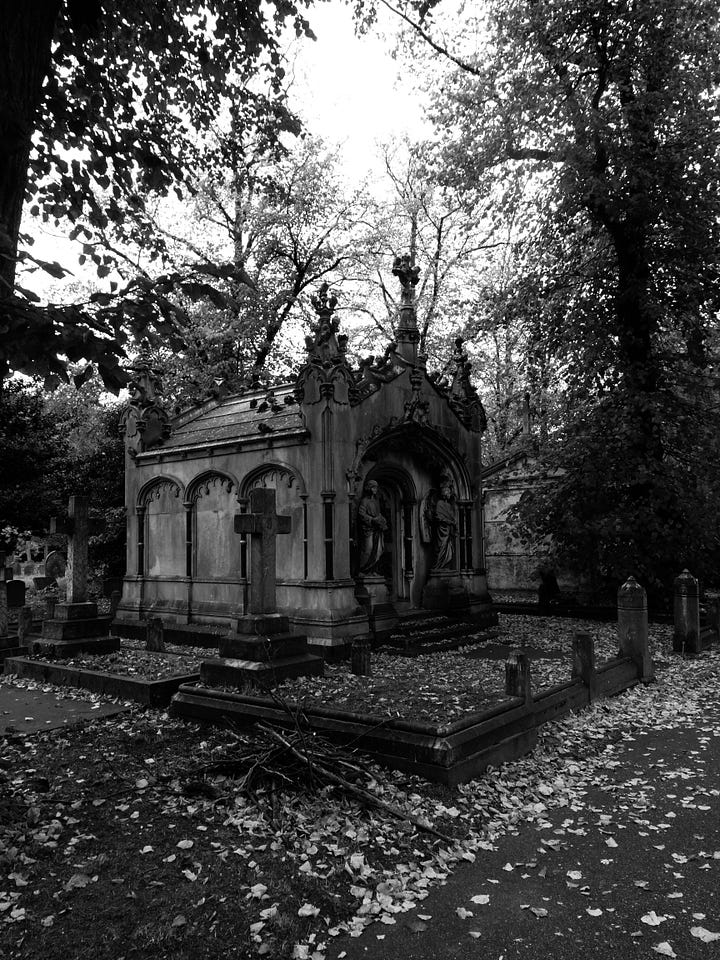
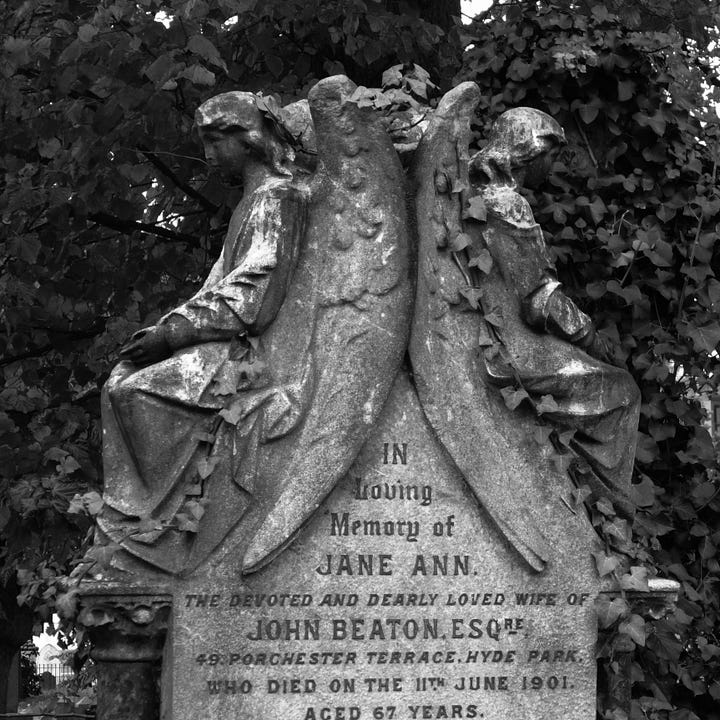
Perhaps it should be noted that angels were most frequently the most expensive option for a memorial, as well as being outrageously popular; Victorian funeral custom was never free from ties of wealth, status, and class. In fact, the era gave birth to the profession of undertaker, my dear. Which brings us to the next talk I attended, on the origins of the funeral industry in the Victorian era, hosted by the wonderful Emma Sparre-Newman, cemetery services manager at Brompton Cemetery.
The Victorians elevated the practice of mourning into art, and quite a costly one, inventing all manner of rituals and traditions to prescribe to the trajectory of grief, with heavy price tags to match. As London churchyards, especially in the early 1800s, started filling up rapidly, the burial acts of the 1830s and 50s gave license for private purpose-built cemeteries (see also; the magnificent seven in London) to open, and then for burial within central London to be banned almost entirely. As the distance then became too great for funeral processions to walk them, the practice of undertaking was established. Whereas before, the body sat at home, accompanied by a layer out, who masked the smell with a variety of fragrant herbs, before being brought to a parish churchyard, now, there was a longer, much more substantial process to be dealt with.
Mourning started becoming a much more extravagant process, especially for those who could afford to follow these fluid, arbitrary rules. The wealthy got inspired by the heraldic funerals of medieval knights, and the common people followed suit. More horses for the funeral procession, more ostrich feathers, more solemn men leading the charge. Queen Victoria herself made a spectacle of her fourty years of mourning her late husband King Albert. Special mourning stationery and dress could make one a fortune, especially because custom denoted that the attire of grief be burnt after mourning. The double exposure of the Victorian funeral is still visible in [Western] burial practices today, but most of their expensive mourning practices are not. One of my long lost favourites is the funeral biscuit, a practice inspired by the notion of “sin eating”. The consumption, of the biscuit in this case, served both to spiritually absolve the deceased of [some of] their sin, and to take it on in their stead. Pre-biscuit, it was common to invite a vagrant to eat a meal beside the corpse of the deceased, for much the same purpose. Much more ironic if the deceased’s sin of choice was gluttony…
My third event, taking place in the evening after the previous talk, was the LMOTD’s concert of “Death and the Maiden” by Schubert, which was especially anticipated because the same event last year had a last-minute change of music, playing “Danse Macabre” instead. If you know me at all, you know the entire “Death and the Maiden” trope / mythos is my absolute bread and butter (I wrote 13k words on it this year, and 12k last year), so hearing the Schubert piece performed live after all this time, in Brompton Cemetery’s gorgeous chapel, was just awe-inspiring. The string quartet did a phenomenal job bringing this dance of bargaining, resistance, and acceptance between Death and the Maiden to life.
Finally, the title of this newsletter actually comes from the fifth LMOTD event, which was a selection of rare silent Edgar Allan Poe films, introduced by BFI curator Bryony Dixon, and scored live by Stephen Horne. We watched “Edgar Allan Poe” (1909), “Martyrs of the Inquisition” (1905), “the Pit, the Pendulum and Hope” (1983), “Rachmaninoffs Prelude” (1927), and “the Fall of the House of Usher” (1928). The latter was notable for its surreal, kaleidoscopic, uncanny style of visuals, taking heavy inspiration from German expressionism. As Madeline Usher succumbs to death, she quite literally descends a staircase of coffins. A notable visual symbol I couldn’t help but note down, my dear. At present I feel it represents very well the march from autumn into the cold underworld of winter. A katabasis of caskets.
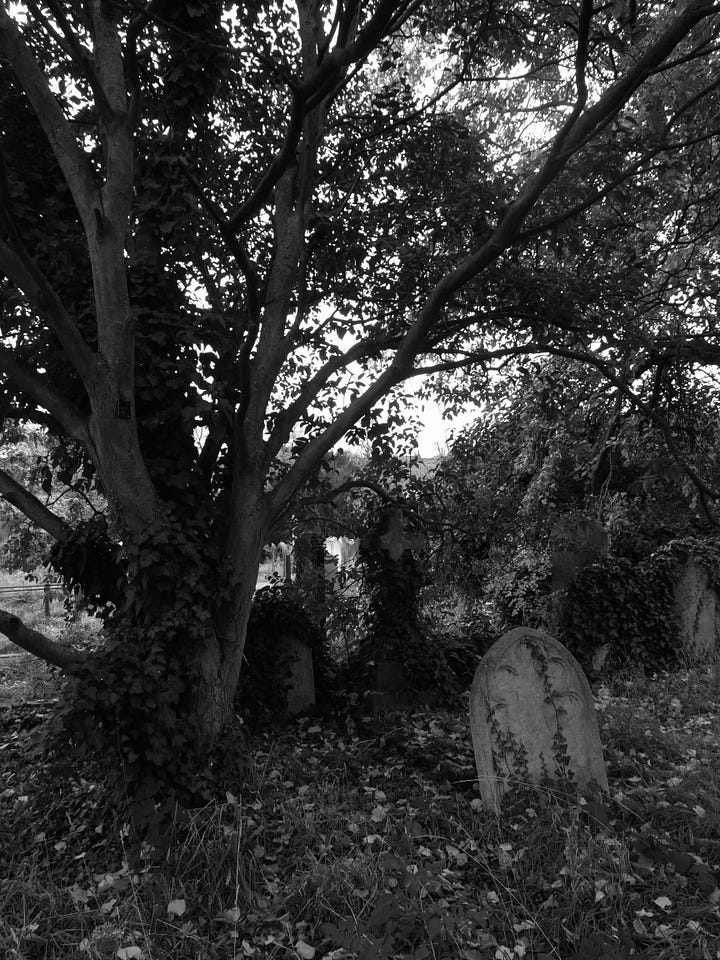
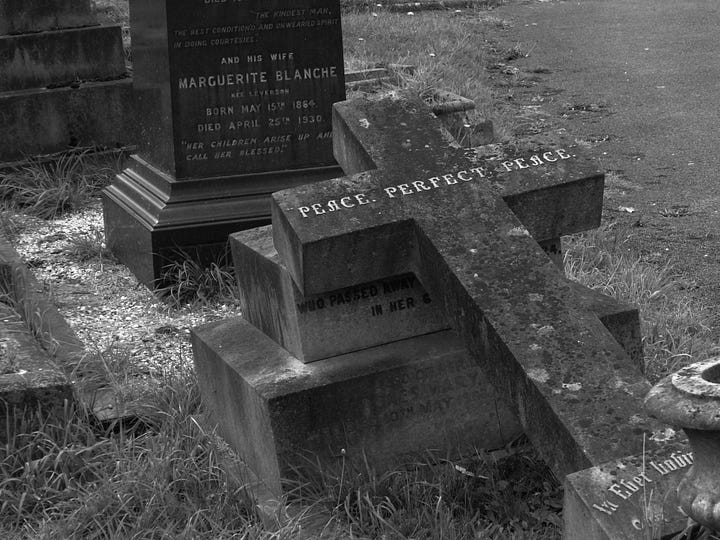
II.II or the Modern Prometheus
In intrepid anticipation of Guillermo del Toro’s “Frankenstein” (2025), that adaptation of Mary Shelley’s beloved novel, I simply had to head down to Selfridge’s to see the limited-time free “Frankenstein: Crafting a Tale Eternal” exhibition of the film’s artwork, costumes, and props. I was pleased to meet with another angel of death here: the “dark angel” statue from the film. Signs and symbols, my dear, are everything to the faithful.
The exhibition was wonderfully immersive, featuring so much superbly imaginative artwork from the making of the film, as well as behind-the-scenes featurettes, and a stunning array of costumes. If there’s anything Guillermo del Toro excels at, it’s creating vibrant Gothic worlds for his films that get the understandably tricky task of balancing colour and darkness just right. His 2015 film “Crimson Peak” is a favourite of mine for this very reason; it proves that Gothic does not necessarily facilitate a monochrome palette (as much as I adore the monochrome look). All the ghosts and melodrama of “Crimson Peak” are just as gloomy when draped in deep red, vibrant teal, and rich gold lighting and costumes, and “Frankenstein” follows suit. The almost haemoglobin-esque patterns of some of the dresses reminded me of the typical endpapers on Victorian books. Needless to say, after the exhibition my enthusiasm reached new heights…

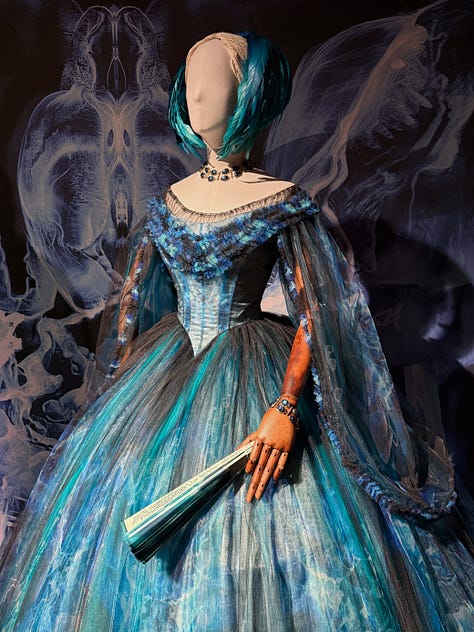



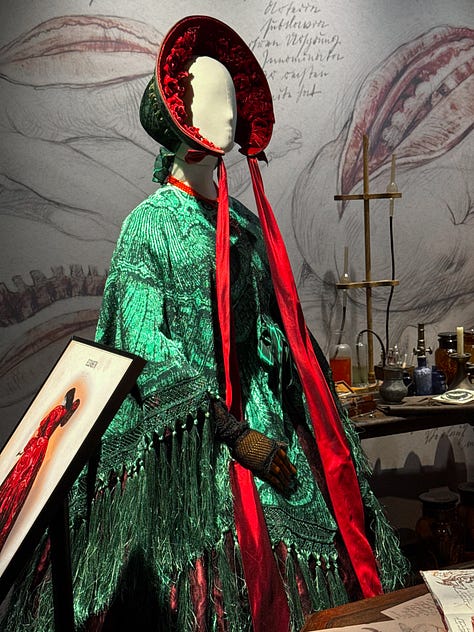
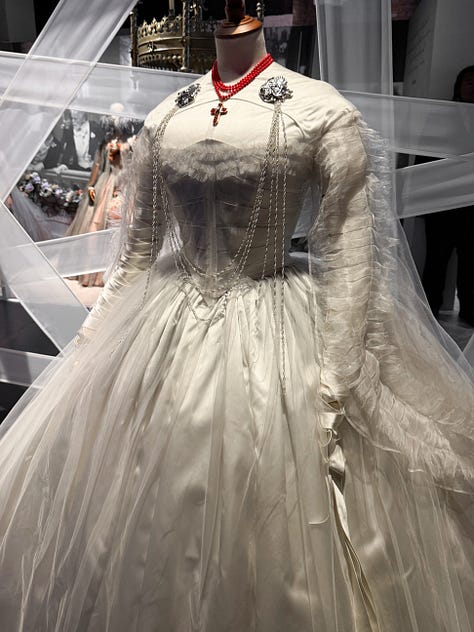
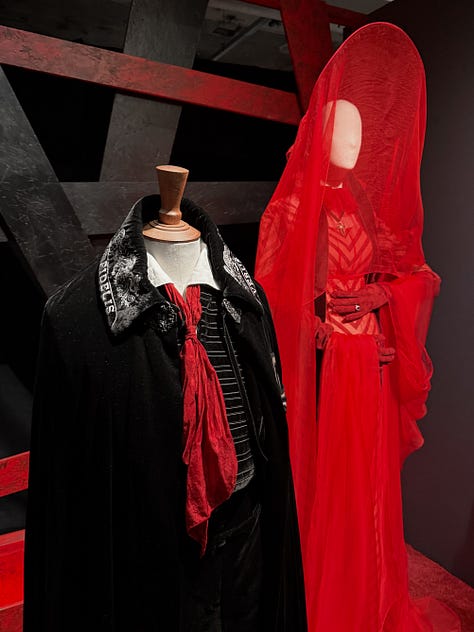
[Light spoilers ahead] As for the film itself, I’m a bit disappointed to tell you that I found it lacking in a fair few areas. I’m never a straight-edge accuracy devotee (I enjoy the very unfaithful Mina/Dracula romance trope, and certainly welcomed the Death and the Maiden inclusion in del Toro’s “Frankenstein”); adaptation is an art form and should not fear re-weaving narratives in order to elevate the material. However, I found almost all of the changes to Victor Frankenstein’s character to do very little in serving the plot or its themes. Generally, I wanted this film to take more from the tone of “Nosferatu” (2024); melodramatic, strong, and much more nuanced (like Mary Shelley’s novel)— del Toro is certainly no stranger to Gothic melodrama. Taking from Eggers does not, however, mean completely giving up on humour; I thought there were many subtle, visual comedic moments in “Nosferatu”, which I appreciate more than the overtly modern humour of “Frankenstein”.
Nevertheless, Jacob Elordi should absolutely be praised for his performance in the film (my definitive version of the creature). I had a great time whenever he was on-screen. As the creature, Elordi is subtle, magnetic, and gentle in a way that doesn’t feel at odds with the film’s very crunchy, punchy moments of violence and gore, saturated with just enough artifice to keep from being stomach-churning. Oscar Isaac’s Victor Frankenstein, on the other hand, is suffering quite largely from a script that refuses him all and any shades of grey. Victor is the monster, plain and simple. He is even told so at one point. In contrast, Mia Goth’s Elizabeth is still shadowy and divisive5 to me— I’ll have to pin down my feelings on her after one or two rewatches, though I always adore Goth’s charm. In broad strokes, the film is stunningly designed, and its world is rich and enchanting, even when the tone or plot falters quite heavily at times. It is neither my favourite del Toro nor my favourite Frankenstein adaptation, but its great elements (costumes, Elordi’s creature, stunning sets) do slightly overwhelm the much more lacklustre parts (plot changes, Victor’s character, tone)… ☆☆☆.5/5
“Since childhood, I’ve been faithful to monsters. I have been saved and absolved by them, because monsters, I believe, are patron saints of our blissful imperfection, and they allow and embody the possibility of failing.”
by Guillermo del Toro, from a 2018 speech


II.III And Other Gatherings
Finally, we have made our way to the “rapid fire” section of these updates. Expect quick notes on everything prior even to October, that did not make it any of the other newsletters (contrary to belief, I do cut for brevity at times). Back in September, I had the privilege of attending the newly-opened “Marie Antoinette Style” exhibition at the V&A here in London, seeing all the little influences of the queen spread throughout fashion, film, and art. Particularly gut-wrenching was the red room, displaying a range of artefacts from the end of Marie Antoinette’s life, from her last written words, to a lock of her hair, and even the (alleged) guillotine blade that took her life. It was a surreal experience, having walked past frills and perfumed interactive elements, to stand there with the orchestral exhibition music swelling, and make eye contact with the last thing to touch the queen in this life.
In late September, I did some event photography for everyone is a girl’s “porno chic” event, a symposium on sex work and art, wonderfully orchestrated by ester freider. I went on Highgate Cemetery’s yearly bat walk, making my way through the twilight cemetery with flashlights like a true horror game protagonist would, and seeing some bat friends in the meanwhile. More than a handful of nights were densely filled with performance and delight. Additionally, I also made a brief foray into Frieze London, on invitation of a dear friend. The galleries were abundant and overwhelming, bustling with people. Predictably enough, I enjoyed Frieze Masters more than the contemporary fare— the swords, Gothic stonework, and the phenomenal Dorothy Cross booth were all favourites. Even if we did get lost in the labyrinthine halls once or twice… It is such a lovely thing to be lost and found again!
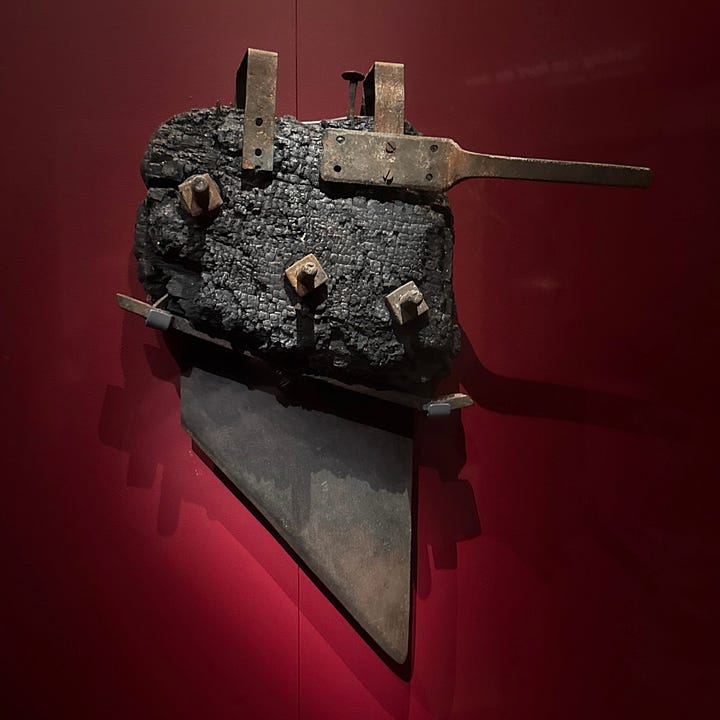
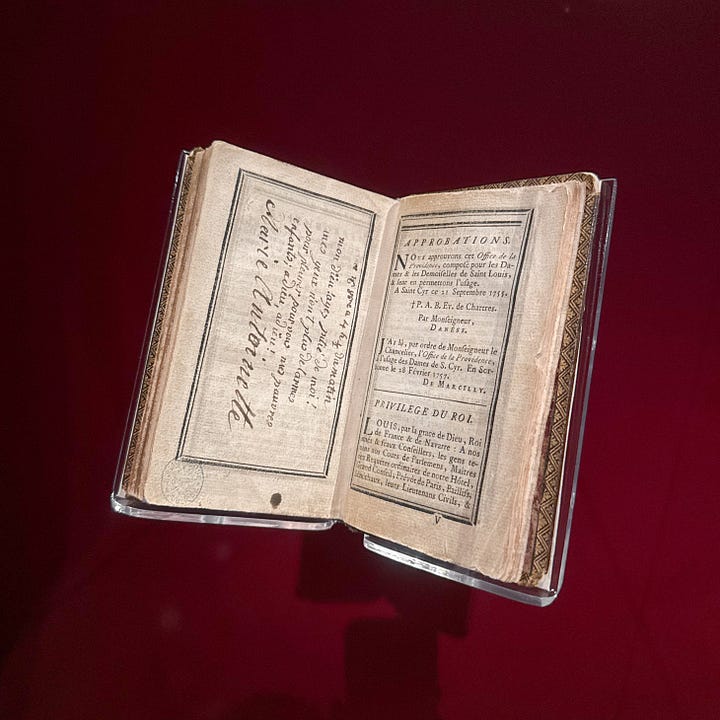
III. Three Years, and Other Omens
“I fell in love with the idea that the mysterious thing you look for your whole life will eventually eat you alive.”
by Laurie Anderson
Happy three years of madness, my dear! When I was little, I was a deeply superstitious child; prone to touching objects, walls, reliquaries, in steady, subtle patterns. Hyperfixated on the exact sensation of the fingertips. I did not believe in doubles, but I did believe in threes; all good things came in multiples of three, uneven numbers. That particular way of thinking has stuck with me through the years, which only serves to make this particular anniversary even more gleaming and more radiant. To turn three is a good omen, my dear.
So many lovely things happened this year; the Society unveiled its new logo illustrated by Julia Jane Martens, we held our first giveaway, and continued building at this wonderful little world of ours. My own ten fingers eagerly typed over one hundred thousand words on the newsletter alone! Not to mention all your lovely submissions, contributions, and suggestions, to the Substack and beyond. If the society is my own creature, and you, my dear are the stitches or the lightning, I suppose that makes me Victor Frankenstein… An analogy with absolutely no latent troubles, none at all! Supposedly there are worse parallels to draw with classic literature… I rather enjoy electrifying my little lab, doing experiments, and playing god ❦.
This year I read even more of your work, attended your plays and events, and donated to your bookshelves. What a joyous thing it is to run this cabinet of curiosities! All you wonderfully twisted kindred spirits are the best company one could ever ask for. For now, I leave you with this year’s overview of stats (I am a virgo after all), and a link to the timeline of the society. Small offerings to show my gratitude. Thank you, thank you, thank you for another year of love and violence. My study is admittedly more than a little cluttered right now, so don’t linger too long. There is much work to be done! Big things are coming, my dear, big things! It’s aliveee!
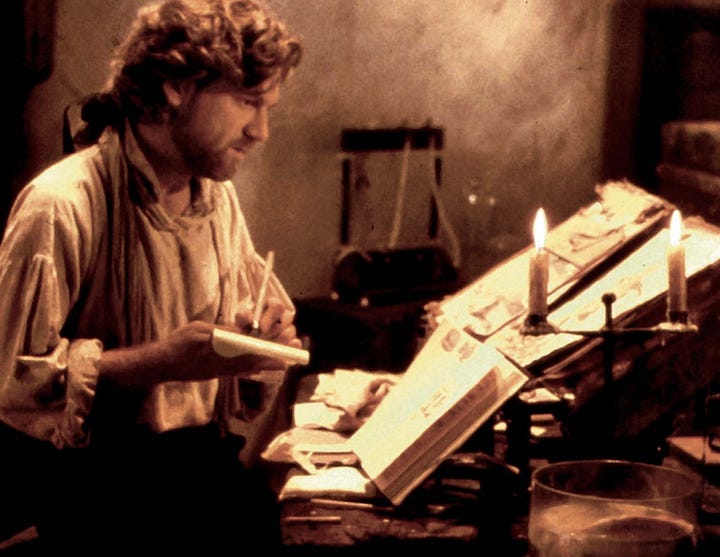

✧・゚: *✧・゚:* On the List *:・゚✧*:・゚
Exhibitions, Events, and Talks. November has many choices for those more esoterically inclined, starting with a workshop on "deer magic" at Treadwell’s on the 9th, as well as "Dark Secrets: the Esoteric Exhibition" on until the 3rd of January, collecting all manner of accursed objects ranging from cursed dolls to other supposedly haunted objects. Similarly, the machinations of the new “Frankenstein” film are still available to view in exhibition at Selfridge’s until the 9th— the film itself will find its way to Netflix on the 7th. For those who prefer the sugar over spice, the V&A is hosting one of their free lunchtime lectures with the curator of their new “Maria Antoinette Style” exhibition (on until the 22nd of March) on the 13th of November.
The Viktor Wynd cabinet of curiosities always hosts an array of wonderfully esoteric events and exhibitions, including a talk on the Gothic in Angela Carter's writing on the 20th, and their new "fairy land" exhibition exhibition starting on the 6th. Additionally, sister collective Ethereal Maison is collaborating with artist Georgia Somerville for an exhibition and three days of events: panel talk and performance on the 6th, a "soft symbols" workshop on the 7th, and finally an interactive food experience on the 8th. Plenty to sink your teeth into, my dear.
Film, Music, and TV. As always, there is a never-ending selection of films screening in London. Choice picks include the “Twilight” (2008) re-release, on at a variety of cinemas, “Nude for Satan” (1974) on at the Nickel Cinema on the 9th, as well as the very enticing “the Erotic Rites of Frankenstein” (1973) on the 20th, and “Death Becomes Her” (1992) on at the Prince Charles Cinema on the 25th. For my fellow winter medievalists, “the Princess Bride” (1987) is screening on the 15th at the Prince Charles Cinema. Currently, it seems the Picturehouse monthly overview is quite broken, but it seems their re-release line-up includes Hitchcock’s 1960 classic “Psycho”, starting on the 3th, alongside 1954’s “Rear Window”.
In the Stars. Most of November is taken up by Scorpio season, so be sure to welcome the sting before moving into Sagittarius season on the 22nd. This month’s full moon will be on the 5th, and will seem extraordinarily large due to being a supermoon. The perfect time for rituals of the soul, and perhaps a bit of lunacy, too. Finally, the new moon will be visible in the sky on the 20th ☆
Obsessive Tendencies: What I’ve Loved Lately
Fangamer, BloodBorne “Hunter’s Dream” t-shirt, [A birthday gift from a beloved friend], $36
MAC, Lustreglass Sheer Shine Lipstick “Alone Time”, [Trending but oh so worth the hype], £25
Hollister, Easy Satin Tie Babydoll Top, [Very horror game protagonist-core], £25.95
Urban Decay, single shadow in “Tease”, [My daily smoky eye staple for the past three years], £21 at Boots
Maggie Lindemann, “i feel everything” on granite vinyl, [A gorgeous blend of chilled dance and Maggie’s signature introspective lyrics— I can’t take it off repeat], £29.99 at HMV
Fiona Horne, “Lost Oracle”, [Lusciously illustrated and uncannily accurate, at least in my readings], £14.05
“The trouble with me is that whether I get love or not / I suffer from it.” // “And thus the heart will break, yet brokenly live on”
by C.K. Williams, from “On the Roof” (1968) // by Lord Byron, from “Childe Harold’s Pilgrimage” (1812-1818)
Oh, pleasant November, the white skies of winter cold. Frigid and harsh. It seems the days are cut in half, regulated by darkness, embraced by night. As part of my rituals, I require an hour minimum every day to succumb to melancholy— what a gift it is to feel something so intensely, so strongly, to be so open to life and love, and death. October was a maelstrom of change, so November will have to be an unfolding of sorts. Gently, so as to not make any tears. I am out searching again, for God knows what. Reading Victorian erotica by candlelight, musings on tenderness and virtue and sin. Stillness and pleasure can and do often go hand in hand. I am empiric evidence of it. My philosophy is that of a night-blooming flower, always blossoming at the least likely moment.
Just a few days ago I carved my very first pumpkin ever: a sleeping beauty, lying on her back. I do not blame her for dozing through the darkness, though the Halloween6 lightning storm was utterly resplendent. My father’s signet ring, which I wear everyday, broke in half in the cinema before watching “Frankenstein” (2025). A bad omen, perhaps. Visions of the folkloric green man still follow me. Bonfire night is to be spent away from Blackberry Hill House, in a cabin by the village of Battle, and the weekend after that I am off to Paris again. So, I suppose that has you all caught up, my dear. Don’t be a stranger, now. Send a letter whenever is convenient! You know where to find me…
Until my next letter,
With love (and violence),
x Sabrina Angelina, the White Lily Society 𐔌՞. .՞𐦯
Currently reading: “the Burial of the Rats” by Bram Stoker // Most recent read: “We Have Always Lived in the Castle” by Shirley Jackson
White Lily Society links // Sabrina Angelina links
Whether you subscribed on day one or three years in, all White Lily Society members are equally important to the cause. Join us to help spread the word about the Intersection of Love and Violence, Gothicism, and Romanticism. Come, become a martyr of deliciousness!
📼 Song of the (past) month: it’s still you - Maggie Lindemann
One of my micro-fixations is always blindfolded characters, especially video game characters ✧・゚: *✧・゚:*
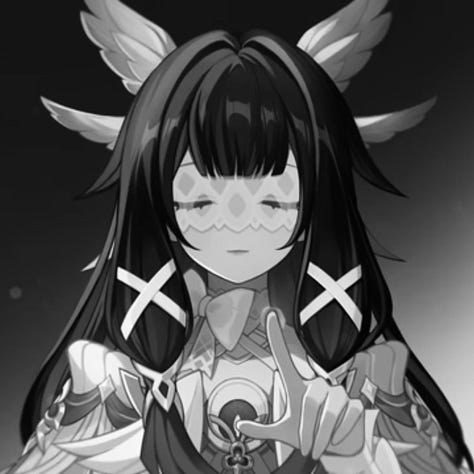

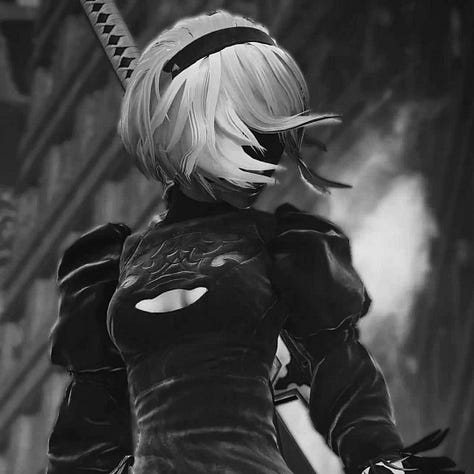
I’m especially fond of the original story trailer for the game: “It happened an age ago […]. On a night of wintry fog, the rune of death was stolen, and the demigods began to fall. Starting with Godwyn the Golden.”
As classified by Dr. Anil Aggrawal; (1) role players, (2) romantic necrophiles, (3) necrophilic fantasisers, (4) tactice necrophiles, (5) fetishistic necrophiles, (6) necromutilomaniacs, (7) opportunistic necrophiles, (8) regular necrophiles, (9) homicidal necrophiles, (10) exclusive necrophiles.
Fun fact; Mausolus’ name is where the word “mausoleum” comes from.
Look, I know it may be odd for me to say; but I don’t mind the disempowered Elizabeth from the novel (I do often enjoy a straightforward damsel, if only for its imagery and not necessarily its implications)— I thought the character was in line with the novel’s recurring pattern of women shouldering the consequences of men’s actions; Justine is executed for the creature’s killing of William, Elizabeth dies at the creature’s hands as revenge against Victor, and the creature hopes to ease the burdens of his loneliness by, essentially, condemning a female companion to the same “monstrous” life.
Del Toro’s Elizabeth, on the other hand, is Victor’s intellectual equal, and shares a deeper bond with the creature. The former I am undecided upon, the latter I welcome, as president of the “Death and the Maiden” trope fan-club. Mia Goth does a compelling job with the material she is given, and her charm was really what sold her performance for me, regardless of my undecided unease with some of its contents.
For those who are interested, I went as “doomcoming” Lottie Matthews from “Yellowjackets” (2021-) for Halloween, complete with my own monochrome interpretation of the headpiece (and faux blackberries glued on).





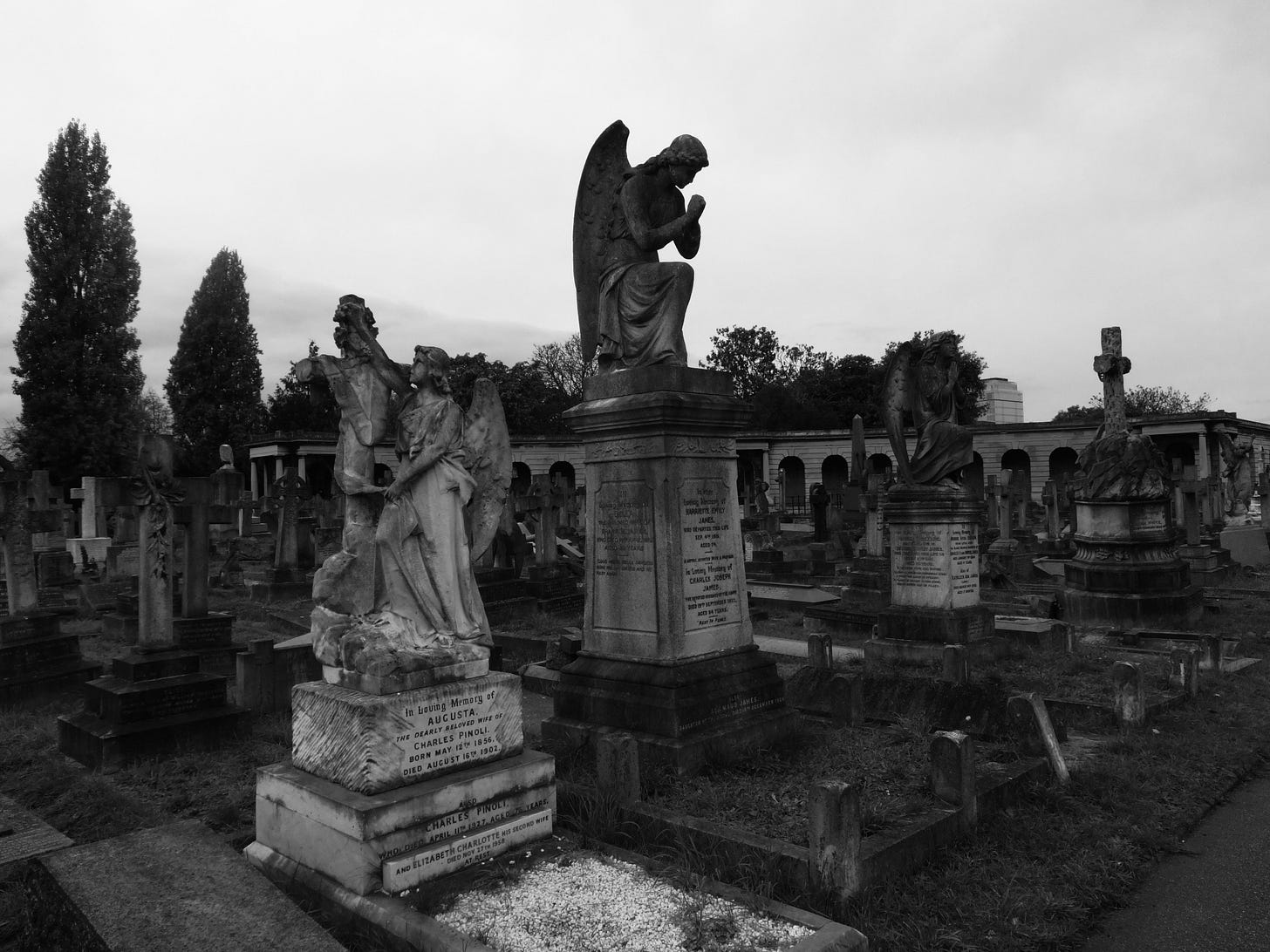
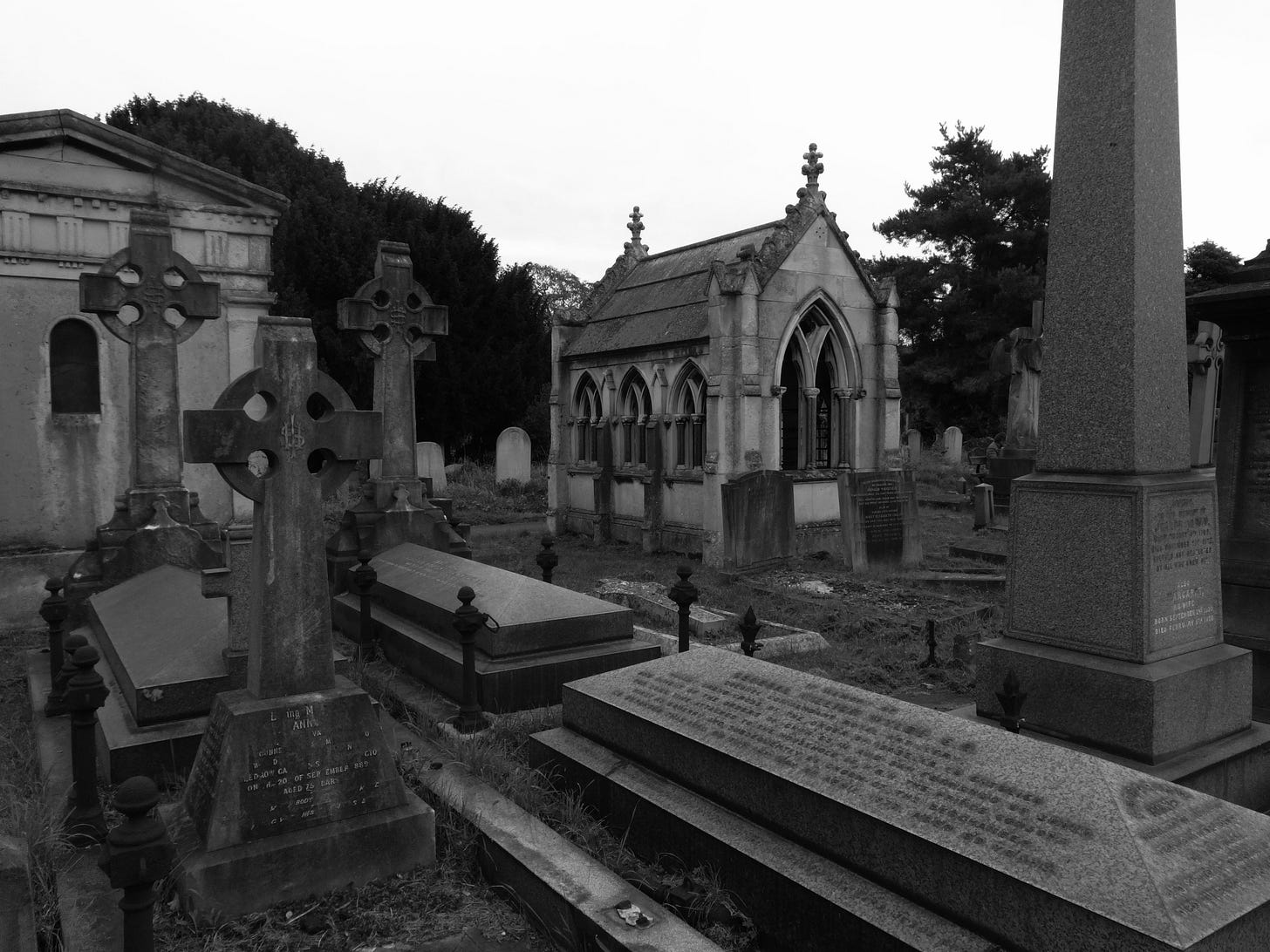

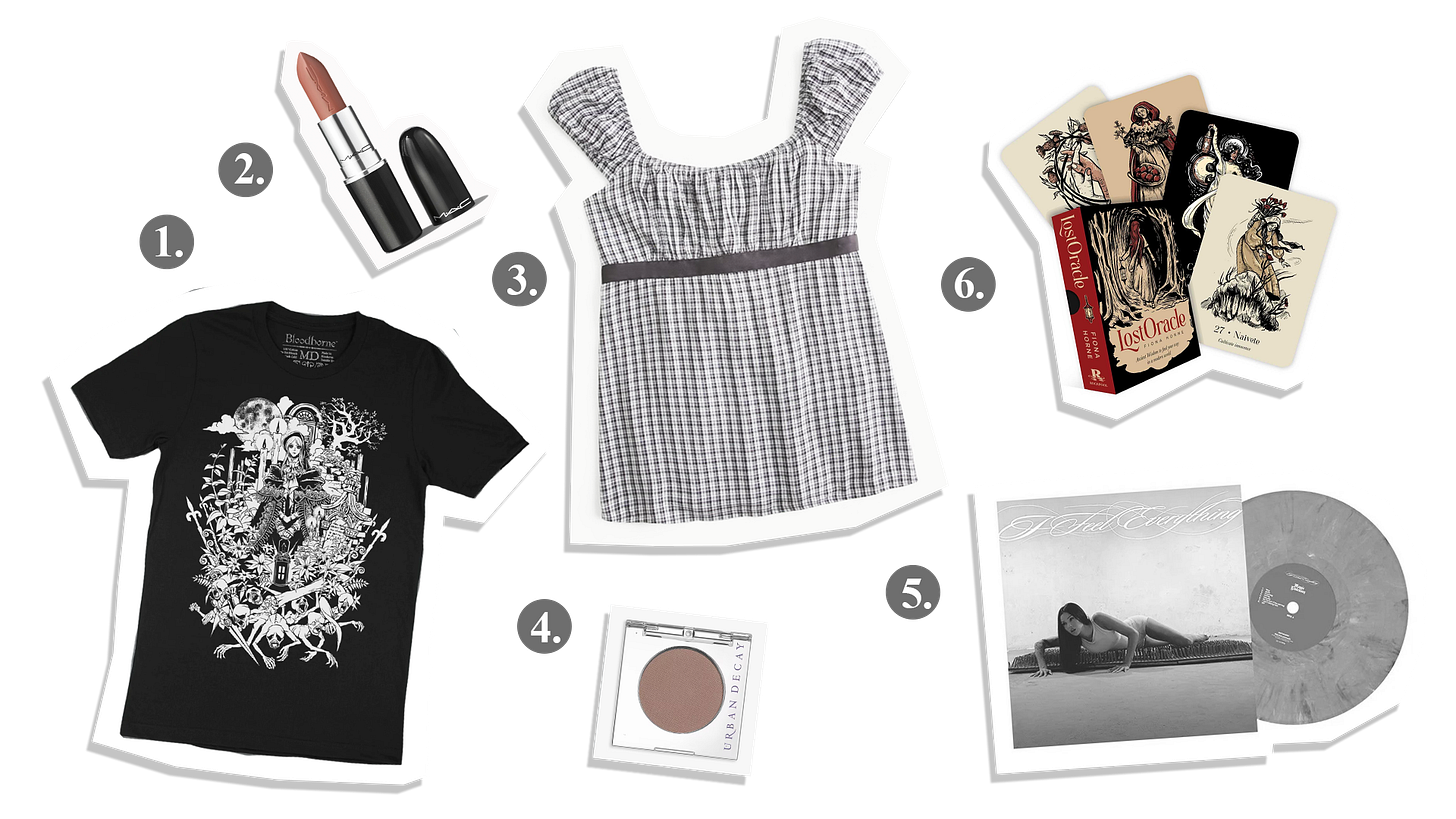
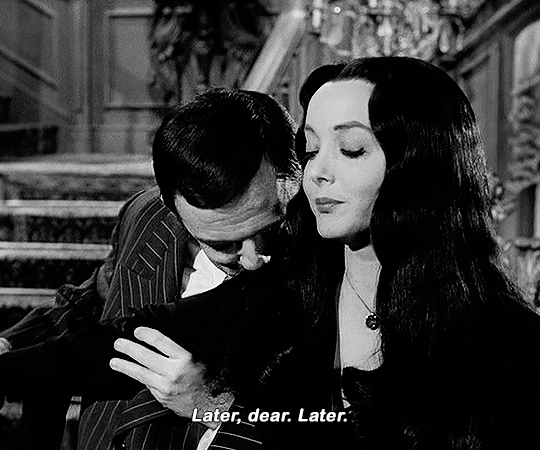


"However, I found almost all of the changes to Victor Frankenstein’s character to do very little in serving the plot or its themes." I have to agree, I found the changes to the structure of the film lost the subtleties Mary wove so deliciously into the novel. Perhaps a sign of that times, that larger audiences must be fed the undertones and can no longer be relied upon to uncover them for themselves.
An interesting take on the new Frankenstein film. I see what you mean about Victor’s lack of nuance. My suspicion is that the character suffers in that respect from del Toro’s intention to identify Victor and God (but really a demiurge), and so is boxed in to Mean Something.